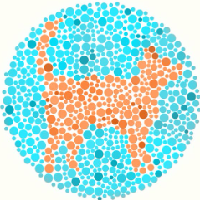
Farnsworth Lantern Test is an optical test with the goal of identifying red-green deficiencies in order to compete for the specific tasks requiring color vision.

The Color Blind Test is an optical test that is designed to determine a person’s type of color blindness and identify whether or not they have a color deficiency.

The Kids Color Blind Test is a simple and cute version of the Ishihara Test that is applied to children who have trouble identifying the difference between colors.

The Ishihara Test, created by Japanese doctor Shinobu Ishihara in 1917, is one of the most famous color blindness tests that can determine red-green color blindness.

The Red-Green Color Blind Test is a color vision examination designed to determine a person’s level of color blindness. It is used to check for red-green deficiency.

Cambridge Test is a quick method for checking people for color vision deficiency and can be used to analyze the changes in color discrimination caused by using medicines.

Color Vision Test is the most prevalent color blindness test type required by your eye doctor to examine an image of colored dots with a number in a different color.

Reaction Time Test is a color vision test that is created to determine how fast you react to different colors. Do this test by combining the harmony of your eye and hand.
1. Eye Conditions and Their Causes
What is Color Blindness?
Several factors can contribute to vision loss and blindness. These influences can be hereditary, environmental, or unintentional. To understand how blindness might influence an individual, it is necessary to first define blindness.
Color blindness, also known as color vision deficit (CVD), is the inability to see color distinctions or variations in color. This syndrome can make it difficult to select ripe products, choose clothes, and observe traffic light signals. Color blindness may make certain academic tasks more challenging. However, most concerns are minor, and colorblind people acquire adaptations and coping methods independently. People with total color blindness (achromatopsia) may be uncomfortable in bright situations and have poor visual acuity.
What are the signs and symptoms of Color Blindness?
The very first sign of color blindness is the inability to see colors as most people do. If you are colorblind, you may have trouble in:
- The distinction between colors.
- How vibrant the colors are.
- Colors in various tints.
Color Blindness symptoms are frequently so faint that they go unnoticed. Many persons with color blindness are unaware of their condition since we become accustomed to how we perceive colors.
People with severe color blindness may also experience other symptoms such as fast side-to-side eye movements (nystagmus) or light sensitivity.
What causes Color Blindness?
The most prevalent types of Color Blindness are hereditary, which means they are passed down from parents or close relatives.
Besides, Color Blindness can also occur as a bad result of eye or brain damage. Color vision may depend on your age and your health as well.
2. Types of Color Blindness
Red-Green Color Blindness:
Red-green color blindness is the most common variety of color deficiency in humans; they can't distinguish between red and green in real life. There are 4 types of red-green color deficiency:
- Deuteranomaly (also known as Deutan color blindness) is the most common type of red-green color blindness. It makes the people who have this syndrome see everything in green become redder.
- Protanomaly, on the other hand, makes the red look more green and brighter. Greens, yellows, oranges, reds, and browns may appear identical as a result, especially in low light. It can also be difficult to distinguish between the blues and the purples or the pinks and the grays.
- Protanopia and deuteranopia both make people who have this syndrome unable to identify the difference between red and green at all.
Blue-yellow color blindness:
Actually, Blue-yellow color blindness is unusual, and the name is deceptive. In fact, the syndrome causes people to mistake certain shades of blue as green and some shades of yellow as violet.
There are 2 typical types of Blue-yellow color blindness:
- Tritanomaly: People who suffer from tritanopia are dichromats. This suggests that the S-cones are completely absent, leaving only long- and medium-wavelength cones.
- Tritanopia: This is a milder form of blue-yellow color blindness in which the S-cones are present but have a mutation.
Complete color blindness (also known as monochromacy):
If a person has complete color blindness, he or she can’t see any colors at all. This syndrome is also called monochromacy. They may have trouble seeing clearly and be more sensitive to the light.
Monochromacy is a rare congenital cone photoreceptor disease that affects around 1 in 30,000 people. Because these patients have normal rod function but no observable cone function, everything they see is in shades of gray (total color blindness).
3. What's the treatment for color blindness?
There is no cure for inherited color blindness, although most people find ways to cope with it. Children with color blindness may require assistance with various classroom tasks, while adults with color blindness may be unable to perform certain vocations, such as piloting or graphic design. Keep in mind that color blindness does not always result in major consequences.
If your color blindness is caused by another medical issue, your doctor will treat the underlying illness. If you are using a medication that causes color blindness, your doctor may alter the dosage or recommend that you switch to a different medication.
If color blindness is interfering with daily work, there are equipment and technologies that can help, such as:
- Using contact lenses and glasses: Colorblind folks may benefit from special contact lenses and spectacles that assist them to distinguish between colors.
- Using visual assistance: Color blindness can be managed with the help of visual aids, apps, and other technology. You can, for example, use an app to take a photo with your phone or tablet and then tap on a portion of the image to determine the hue of that region.
4. How to test Color Blindness
Step 1: Before taking the test, remove any glasses with colored lenses. Taking this test with only your prescription lenses or the naked eye will provide you with the most accurate results. Wearing a colored lens may affect your results, making them inaccurate.
Step 2: Turn up your screen's brightness: brighter colors are easier to perceive. The test consists of a series of color-blind test plates, which form the shape of a one or two-digit number. If you are unsure about the number on the test plate, type in your best guess. You can also select "skip" or "unsure" to move on to the next question.
5. The ways to test Color Blindness
There are numerous tests available to diagnose color vision loss, but the Ishihara Test is the gold standard. This will put the red-green type to the test. Normal color vision, it is most often used in government jobs, schools, and medical settings.
Besides, there are some useful tests that can be used to determine Color Blindness: Color Vision Test, Lantern Test, Red Green Color Blind Test, Reaction Time Test, and Cambridge Color Test.
Those above are tests for adults. For kids who are unable to identify numbers and letters, there is also a unique test for them called the Kids Color Blind Test.
